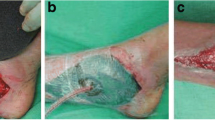Abstract
Diabetic foot wounds present a great challenge to surgeons. They are difficult to heal and are a significant risk factor for non-traumatic foot amputation besides being a huge financial burden. NPWT systems commercially available (VAC™ system, KCI Inc., USA) are costly precluding widespread use. To determine whether negative-pressure wound therapy (NPWT) would afford quicker wound recovery as compared to saline-moistened gauze in the treatment of diabetic foot wounds. Sixty patients were randomized into either the experimental NPWT group or conventional dressing group (control). All patients were given medical therapy for diabetes and antibiotics given according to culture and sensitivity patterns. All foot ulcers were surgically debrided prior to initiation of NPWT or conventional treatment. In the NPWT group, dressings were changed every 48–72 h. In the control group, conventional dressings were applied at the time of surgical debridement and changed twice a day thereafter. End point of study was when wound was ready for either skin grafting or secondary suturing. End point was achieved in the NPWT group in 17.2(SD ± 3.55) days, compared to 34.9 (SD ± 5.96) days in the control group (p < 0.001). Number of dressing applied were 7.46(SD ± 2.25) in NPWT group versus 69.8(SD ± 11.93) in conventional dressing group (p < 0.001). Ninety percent cases were successfully treated in NPWT Group as compared to 76.6 % in conventional group. Rate of healing of ulcer is faster in NPWT group as compared to conventional group. Economically modified NPWT is more cost-effective to the patients in our setup.


Similar content being viewed by others
References
Center for Disease Control and Prevention (2005) 2005 National Diabetes Fact Sheet: general information and national estimates on diabetes in the United States. Center for Disease Control and Prevention , Atlanta
Brem H, Shehan P, Rosenberg HJ, Schnieder JS, Boulton AJM (2006) Evidence based protocol for diabetic foot ulcers. Plast Reconstr Surg 117:193S–207S
Day MR, Fish SE, Day RD (1998) The use and abuse of wound care materials in the treatment of diabetic ulcerations. Clin Podiatr Med Surg 15(1):139–150
Eneroth M, van Houtum WH (2008) The value of debridement and vacuum-assisted closure (V.A.C.) therapy in diabetic foot ulcers. Diabetes Metab Res Rev 24(Suppl 1):S76–S80
Argenta LC, Morykwas MJ (1997) Vacuum-assisted closure: a new method for wound control and treatment: clinical experience. Ann Plast Surg 38(6):563–576
Morykwas MJ, Argenta LC (1997) Vacuum-assisted closure: a new method for wound control and treatment: animal studies and basic foundation. Ann Plast Surg 38(6):553–562
Borgquist O, Ingemansson R, Malmsjö M (2010) Wound edge microvascular blood flow during negative-pressure wound therapy: examining the effects of pressures from −10 to −175 mmHg. Plast Reconstr Surg 125(2):502–509
The science behind VAC therapy. http://www.kci-medical.in/IN-ENG/sciencebehindvactherapy. Accessed 1 Dec 2012
Kairinos N, Voogd AM, Botha PH, Kotze T, Kahn D, Hudson DA, Solomons M (2009) Negative-pressure wound therapy II: negative-pressure wound therapy and increased perfusion. Just an illusion? Plast Reconstr Surg 123(2):601–612
Fleischmann W, Lang E, Russ M (1997) Treatment of infection by vacuum sealing. Unfallchirurg 100(4):301–304
Armstrong DG, Lavery LA (2005) Negative pressure wound therapy after partial diabetic foot amputation: a multicentre, randomised controlled trial. Lancet 366(9498):1704–1710
McCallon SK, Knight CA, Valiulus JP, Cunningham MW, McCulloch JM, Farinas LP (2000) Vacuum assisted closure versus saline moistened gauze in healing of postoperative diabetic foot wounds. Ostomy Wound Management 46:28–34
Blume PA, Walters J, Payne W, Ayala J, Lantis J (2007) Comparison of negative pressure wound therapy using vacuum-assisted closure with advanced moist wound therapy in the treatment of diabetic foot ulcers: a multicenter randomized controlled trial. Diabetes Care 31(4):631–636, Epub 2007
Thomas S (2001) An introduction to the use of vacuum assisted closure. http://www.worldwidewounds.com/2001/may/Thomas/Vacuum-Assisted-Closure.html. Accessed 1 Nov 2012
Mouës CM, van den Bemd GJ, Meerding WJ, Hovius SE (2005) An economic evaluation of the use of TNP on full-thickness wounds. J Wound Care 14(5):224–227
Philbeck TE Jr, Whittington KT, Millsap MH, Briones RB, Wight DG, Schroeder WJ (1999) The clinical and cost effectiveness of externally applied negative pressure wound therapy in the treatment of wounds in home healthcare Medicare patients. Ostomy Wound Manage 45:41–50
Bui TD, Huerta S et al (2006) Negative pressure therapy with off the shelf components. Am J Surg 2006:235–237
Shalom A, Eran H, Westreich M, Friedman T (2008) Our experience with a “homemade” vacuum-assisted closure system. Isr Med Assoc J 10(8–9):613–616
Sahni A: A study of Medical services infrastructure and utilization in Gujarat State. http://medind.nic.in/haa/t00/i1/haat00i1p96g.pdf. Accessed 1 Dec 2012
Andros G, Armstrong DG et al. (2006) Consensus statement on negative pressure wound therapy (V.A.C. therapy) for the management of diabetic foot wounds. Ostomy Wound Manage 2006 Jun; Suppl:1–32
Author information
Authors and Affiliations
Corresponding author
Rights and permissions
About this article
Cite this article
Vaidhya, N., Panchal, A. & Anchalia, M.M. A New Cost-effective Method of NPWT in Diabetic Foot Wound. Indian J Surg 77 (Suppl 2), 525–529 (2015). https://doi.org/10.1007/s12262-013-0907-3
Received:
Accepted:
Published:
Issue Date:
DOI: https://doi.org/10.1007/s12262-013-0907-3




